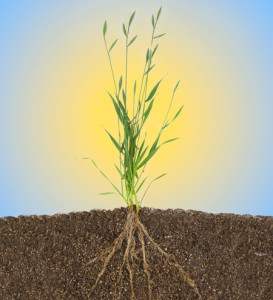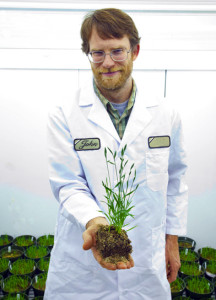WALNUT CREEK, CA—As the U.S. Department of Energy (DOE) works toward developing sustainable sources of clean renewable energy, perennial grasses have emerged as major candidates for the commercial production of cellulosic biofuels from feedstocks. However, little is known about the specific biological traits of the grasses that might contribute to their usefulness for energy production, in part because such grasses typically have long lifecycles and possess large, complex genomes, making them difficult to study.

Brachypodium completes the set of strategically sequenced major grass
genomes from the three most economically important subfamilies of grasses.
Representative genomes for two of the three major subfamilies of grasses—those that include rice, maize, sorghum and sugar cane—have already been sequenced. Now in the February 11 edition of the journal Nature, the International Brachypodium Initiative, a consortium which includes researchers from the DOE Joint Genome Institute (DOE JGI), presents the complete sequence of the wild grass Brachypodium distachyon. B. distachyon has many features in common with grasses, making it an ideal tool for developing grasses specifically tailored for biomass and biofuel production.
As the first wild grass species to be sequenced, Brachypodium completes a strategic triad of sequenced major grass genomes, from the three most economically important subfamilies of grasses, enabling researchers to compare complete genomes across these three grass subfamilies for the first time. With its 272 million-nucleotide genome now available to the public, the tiny grass affectionately known to its devoted research community as “Brachy” also serves as a genomic navigation system for rapidly tracking down traits of agronomic interest within the much larger wheat and barley genomes (16 billion and five billion nucleotides, respectively).

DOE JGI collaborator John Vogel of the U.S. Department of Agriculture (USDA) Agricultural Research Service (ARS) with the first wild grass to be sequenced, Brachypodium distachyon.
“The sequencing and analysis of the Brachypodium genome is an important advance toward securing sustainable supplies of food, feed and fuel from new generations of grass crops,” said DOE JGI collaborator John Vogel of the U.S. Department of Agriculture (USDA) Agricultural Research Service (ARS). “Since Brachypodium has the traits required to serve as a functional model system—small size, short lifecycle, self fertility, simple growth requirements, small genome and can be efficiently transformed or genetically altered—it can be used to more rapidly gain the knowledge about basic grass biology necessary to develop superior grass crops. This is especially important in the context of developing grasses as biofuel crops because the crops themselves (e.g. switchgrass and Miscanthus) are difficult experimental subjects due to their large size, long lifecycle and complex genetics.”
The publication describes how manual annotation of the Brachy genome revealed the structure and possible function of nearly 2,800 of its more than 25,500 predicted genes. This effort, led by Vogel, Jeremy Schmutz and Dan Rokhsar of the DOE JGI, David Garvin of the USDA-ARS and University of Minnesota, Todd Mockler of Oregon State University and Michael Bevan of the John Innes Centre, UK, also compared Brachypodium, sorghum, and rice to determine their evolutionary relationships. The genome analysis was conducted by an international collaboration that also involved the Helmholz-Zentrum in Munich, Germany, INRA in Clermont Ferrand, France, the University of Zurich, Switzerland, and the University of Helsinki, Finland.
“The overall similarity in gene content and gene family structure between Brachypodium, sorghum, and rice supports the value of Brachy as a functional genomics model for all grasses, including those being developed as biomass crops,” said Jeremy Schmutz, a DOE JGI scientist at the HudsonAlpha Institute of Biotechnology in Alabama. Its genetic code promises broad applicability because the subfamily Pooideae, of which Brachypodium is a member, includes most cool season cereal, forage and turf grasses, and with over 3,000 species is the largest grass subfamily.
One of the study’s senior authors, Dan Rokhsar, head of DOE JGI’s Computational Genomics group, added that the wild grass’s genome is also useful for studying the changes wrought by the domestication of other grasses to produce varieties better suited to human needs. Studying Brachypodium’s genome, he said, could provide insight into the origin of genetic traits and pre-existing variations.
Other authors on the study include DOE JGI’s Kerrie Barry, Susan Lucas, Miranda Harmon-Smith, Kathleen Lail, Hope Tice, Erika Lindquist and Mei Wang. For more information about the institutions participating in the International Brachypodium Initiative, go to http://www.brachypodium.org/.
The U.S. Department of Energy Joint Genome Institute, supported by DOE’s Office of Science, is committed to advancing genomics in support of DOE missions related to clean energy generation and environmental characterization and cleanup. DOE JGI, headquartered in Walnut Creek, Calif., provides integrated high-throughput sequencing and computational analysis that enable systems-based scientific approaches to these challenges. Follow DOE JGI on Twitter.